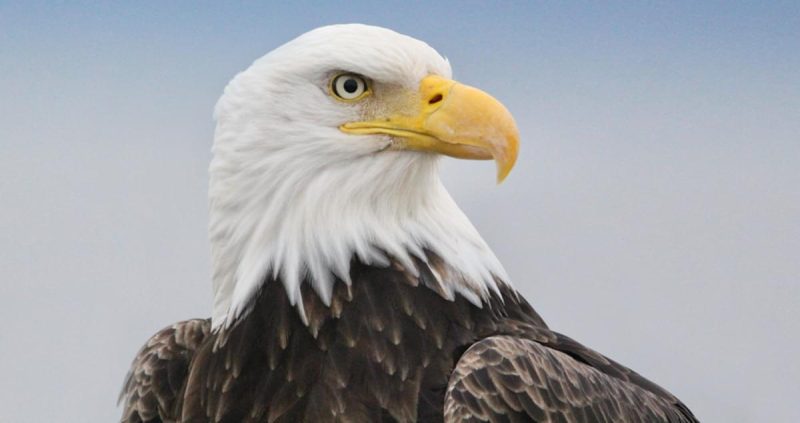California is a state known for its diverse landscapes, ranging from towering mountains to vast coastlines, lush forests to expansive deserts. Amid this natural beauty, majestic eagles soar gracefully across the skies, captivating birdwatchers and nature enthusiasts alike. Eagles in California are not only symbols of power and freedom but also important indicators of a healthy ecosystem.
This article will take you on a journey to discover the most remarkable eagle species in California and the best places to spot these magnificent birds.
Understanding the Eagles of California
Eagles are among the largest birds of prey, admired for their strength, keen eyesight, and soaring flight. In California, two primary species dominate the skies: the Bald Eagle and the Golden Eagle. Each has unique traits, behaviors, and preferred habitats, making them fascinating to study and observe.
Bald Eagle: The Iconic National Symbol

The Bald Eagle (Haliaeetus leucocephalus) is not only the national bird of the United States but also one of the most majestic raptors found in the wilds of California. Instantly recognizable, this eagle features a gleaming white head and tail that sharply contrast with its dark chocolate-brown body and wings. Its massive yellow bill, large talons, and fierce eyes give it a commanding appearance. Juvenile Bald Eagles, however, are entirely brown with mottled white markings and lack the distinctive white head until they reach maturity at around five years of age.
In terms of size, the Bald Eagle is among the largest birds of prey in North America. Adults typically measure between 28 to 40 inches in length, with an impressive wingspan ranging from 6 to 7.5 feet. Males are slightly smaller than females, which is common among birds of prey. When gliding over water or perched high in a tree, their immense wings and noble stature make them one of the most awe-inspiring sights in the sky.
Bald Eagles are known for their strong association with water. In California, they are most often spotted near large lakes, reservoirs, estuaries, and coastal rivers. Fish make up the majority of their diet, although they will also scavenge carrion or prey on small mammals and waterfowl when necessary. They are powerful hunters but are equally opportunistic—sometimes stealing food from other birds such as ospreys. Bald Eagles are monogamous and known to return to the same nesting sites year after year. Their nests, called aeries, are massive and can weigh over a ton after multiple seasons of use and rebuilding.
Fun Fact: Bald Eagles have one of the largest nests of any bird in the world. The largest recorded nest measured over 9 feet wide and 20 feet deep, located in St. Petersburg, Florida! In California, such nests are often built high in trees near water bodies and are carefully protected by wildlife officials to ensure breeding success.
Golden Eagle: The Regal Hunter of the West

The Golden Eagle (Aquila chrysaetos) is one of the most powerful and awe-inspiring birds of prey found in California. This magnificent raptor is easily identified by its dark brown plumage, accented with a striking golden sheen on the back of its head and neck—giving the bird its regal name. Unlike the white-headed Bald Eagle, the Golden Eagle maintains a consistent dark appearance throughout adulthood, although juveniles may display distinctive white patches at the base of the tail and under the wings.
Golden Eagles are large and muscular birds, with adults typically measuring between 30 to 40 inches in length and boasting a wingspan of up to 7.5 feet. They are built for speed and strength, capable of diving at over 150 miles per hour to catch prey. Their massive talons and sharp, hooked beaks are perfectly adapted for hunting a wide range of mammals. While they may appear slightly leaner than Bald Eagles, Golden Eagles are often more aggressive and agile in the air, allowing them to dominate rugged landscapes with ease.
In California, Golden Eagles are most commonly found in open country, rocky outcrops, canyons, foothills, and mountainous regions—particularly in areas like the Mojave Desert, Sierra Nevada, and the Central Coast ranges. These habitats offer plenty of space to soar and abundant prey such as jackrabbits, ground squirrels, and even young deer or foxes. Golden Eagles are expert hunters, capable of taking down prey larger than themselves, and are known to work in pairs when attacking difficult targets.
Their nesting habits also set them apart. Golden Eagles prefer remote, undisturbed cliffs or tall trees to build their large stick nests, which can be reused and added to each breeding season. They lay 1 to 3 eggs, and only the strongest chicks usually survive to fledging age, especially in years when food is scarce.
Fun Fact: Golden Eagles have been used in falconry for thousands of years and are still trained by nomadic hunters in Central Asia today. They are capable of taking down wolves in those regions—showcasing the sheer strength and skill of this incredible bird. In California, while they aren’t used in falconry, they continue to command respect as one of the most iconic predators of the open skies.
Where to Spot Eagles in California
California offers numerous prime locations to observe these magnificent birds in their natural habitats. The variety of landscapes means birdwatchers have many opportunities to witness eagles soaring or nesting.
Shasta-Trinity National Forest: A Bald Eagle Haven
Located in Northern California, the Shasta-Trinity National Forest is one of the best places to see Bald Eagles. The forest is home to numerous lakes and reservoirs like Lake Shasta and Trinity Lake, providing abundant fishing opportunities for the eagles.
During the winter months, Bald Eagles migrate to this area, drawn by the availability of open water where fish remain accessible. Visitors often spot them perched on tree branches near the shoreline or soaring overhead in search of prey.
The forest’s diverse ecosystem, including old-growth trees, ensures safe nesting sites for these birds. Birdwatching tours in the area often highlight eagle sightings as a key attraction.
Klamath Basin National Wildlife Refuge: A Winter Sanctuary
The Klamath Basin, straddling the California-Oregon border, is a critical habitat for many bird species, including a large population of Bald Eagles. This refuge features marshes, wetlands, and lakes, offering ideal conditions for eagles, especially in the colder months.
From late fall through early spring, hundreds of Bald Eagles gather here to feed and roost. The refuge provides excellent observation points where enthusiasts can witness eagles diving for fish or resting along the water’s edge.
The surrounding wetlands also support a rich variety of other wildlife, making it a vibrant ecosystem for nature lovers.
Big Sur and the Central Coast: Golden Eagles Over the Mountains
For those interested in spotting Golden Eagles, the rugged mountain ranges of Big Sur and the Central Coast region are perfect destinations. The steep cliffs, open grasslands, and forested areas provide an ideal habitat for these skilled hunters.
Golden Eagles patrol these open skies, often seen soaring high above the coast or gliding close to mountain ridges. The diverse terrain supports their prey, allowing the eagles to thrive in these regions.
Hiking trails around Big Sur offer birdwatchers a chance to see Golden Eagles in flight while enjoying some of California’s most breathtaking scenery.
Anza-Borrego Desert State Park: Desert Eagles
While deserts might seem inhospitable, the Anza-Borrego Desert is home to a surprising population of Golden Eagles. This vast state park features rugged desert landscapes and canyons where Golden Eagles nest on rocky cliffs.
The park’s open spaces provide clear visibility, making eagle sightings more frequent. The desert environment also supports various small mammals, which serve as prey for these raptors.
Visiting in the cooler months increases the likelihood of spotting these resilient birds as they soar across the arid terrain.
Lake Tahoe Basin: Eagles in the Mountains and Lakes
Lake Tahoe, straddling the California-Nevada border, is a scenic hotspot for Bald Eagle sightings. The pristine waters of the lake and its tributaries attract eagles year-round, but especially in winter.
The combination of large water bodies and surrounding forests creates a perfect habitat for Bald Eagles to fish and nest. Visitors often see eagles perched in tall pine trees or circling high above the lake’s surface.
Wildlife tours and guided birdwatching expeditions are popular here, with experts helping visitors identify and learn about the eagles’ behavior.
Tips for Spotting Eagles in California
Spotting eagles in the wild requires patience, the right timing, and some knowledge of their habits and habitats.
Best Time to Observe Eagles
Eagle activity varies by season and species. For Bald Eagles, winter is the peak time in many parts of California, as they migrate to areas with open water to fish. Golden Eagles can be seen throughout the year, but early spring and fall offer ideal conditions during their breeding and migration periods.
Early mornings and late afternoons are often the best times to see eagles hunting or soaring, as they take advantage of thermal currents to glide effortlessly.
Equipment and Preparation
While it’s possible to spot eagles with the naked eye, binoculars or a spotting scope greatly enhance the experience. A good camera with a zoom lens is ideal for capturing their majestic flight and detailed features.
Dress appropriately for the location and weather conditions. Some prime eagle habitats may involve hiking or spending extended time outdoors, so comfortable footwear, water, and sun protection are essential.
Respecting the Eagles and Their Habitat
When observing eagles, it is important to keep a respectful distance to avoid disturbing their natural behavior. Approaching nests or hunting areas too closely can stress the birds or cause them to abandon their nests.
Stick to established trails and observation points, and follow guidelines provided by parks or wildlife refuges. Responsible birdwatching ensures the continued health and safety of these magnificent creatures.
The Importance of Eagles in California’s Ecosystem
Eagles play a crucial role as apex predators in California’s ecosystems. By preying on fish, mammals, and carrion, they help maintain balance in the food chain and promote biodiversity.
Their presence also reflects the quality of the environment. Healthy eagle populations often indicate clean waterways, abundant prey, and preserved natural habitats. Conservation efforts focused on protecting eagles benefit countless other species sharing the same environment.
Moreover, eagles inspire people with their strength, resilience, and grace. They serve as ambassadors for wildlife conservation, drawing attention to the need to protect California’s natural heritage.
Conservation Status and Efforts
Both Bald and Golden Eagles have faced challenges due to habitat destruction, pollution, and past use of harmful pesticides like DDT. Thanks to legal protections such as the Bald and Golden Eagle Protection Act and habitat restoration programs, their populations have significantly recovered.
California’s wildlife agencies, non-profit organizations, and dedicated volunteers continue to monitor eagle populations, protect nesting sites, and educate the public about these majestic birds.
Supporting conservation initiatives and responsible tourism helps ensure that future generations can also enjoy the sight of eagles soaring over California’s skies.
Frequently Asked Questions About Eagles in California
What species of eagles can be found in California?
The two primary species of eagles found in California are the Bald Eagle and the Golden Eagle. Bald Eagles are usually seen near bodies of water where they fish, while Golden Eagles prefer mountainous and open terrain for hunting.
When is the best time to see eagles in California?
The best time to spot Bald Eagles is typically during the winter months when they migrate to areas with open water. Golden Eagles can be observed year-round, but spring and fall are especially good during breeding and migration periods.
Where are the top locations to spot eagles in California?
Some of the best places include Shasta-Trinity National Forest, Klamath Basin National Wildlife Refuge, Big Sur, Anza-Borrego Desert State Park, and the Lake Tahoe Basin. Each location offers unique habitats suited for either Bald or Golden Eagles.
What should I bring when going eagle watching in California?
Bringing binoculars or a spotting scope is highly recommended for a better view. A camera with a zoom lens, comfortable clothing, sun protection, and water are also important, especially if you plan to hike or spend several hours outdoors.
Are eagles protected by law in California?
Yes, both Bald and Golden Eagles are protected under federal laws such as the Bald and Golden Eagle Protection Act. These laws make it illegal to harm, harass, or disturb eagles, especially near their nesting sites.
Can I approach eagle nests or young eagles for a closer look?
No, it’s important to maintain a respectful distance from eagle nests and young birds. Disturbing them can cause stress or even abandonment of the nest. Always observe eagles from designated observation points or trails.
Why are eagle populations important for California’s ecosystem?
Eagles are apex predators and help maintain balance in ecosystems by controlling populations of prey animals. Their presence also indicates a healthy environment with clean water and abundant wildlife.
How have eagle populations in California changed over time?
Eagle populations, particularly Bald Eagles, declined sharply due to habitat loss and pesticide use in the mid-20th century. Thanks to conservation efforts, including habitat protection and banning harmful chemicals, their numbers have rebounded significantly.
Can I participate in eagle conservation efforts in California?
Yes, many organizations welcome volunteers for monitoring eagle populations, habitat restoration, and public education. Supporting wildlife refuges and responsible eco-tourism also contributes to eagle conservation.
Final Thoughts: Embracing the Majesty of California’s Eagles
Discovering the majestic eagles in California is an unforgettable experience that connects us with the wild spirit of this incredible state. Whether you are a seasoned birdwatcher or a casual nature lover, spotting a Bald or Golden Eagle in the wild is a moment filled with awe and inspiration.
From the serene waters of Shasta-Trinity to the rugged cliffs of Big Sur, California offers diverse landscapes where these regal birds reign supreme. Planning your visit during peak seasons, respecting wildlife guidelines, and exploring the right locations will enhance your chances of witnessing the grandeur of eagles in flight.
By learning about and appreciating these remarkable raptors, we deepen our connection to the natural world and contribute to preserving its wonders for the future.






